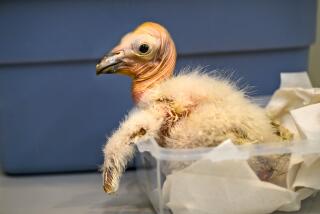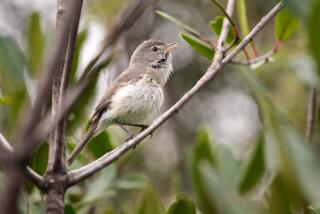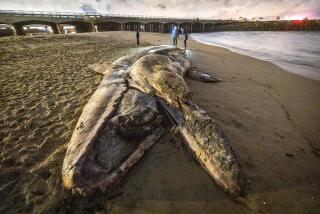Migrating Back From Near-Extinction
- Share via
BLACKJACK POINT, Texas — Tommy Moore deftly guided his tour boat through the shallows of Aransas Bay. A sixth-generation Texan with rosy cheeks and an easy smile, Moore has an uncanny ability to spot wildlife both rare and common from his perch on the Skimmer’s upper deck, and on this excursion, he has plenty of chances to show off.
There were laughing gulls and herring gulls, brown pelicans and white pelicans, a hawk carrying a snake in its talons and a wild pig devouring a fish or, as Moore generously called it, “sushi.” Still, Moore’s prize was elusive, prompting him to throw his hands from his chrome steering wheel and ask: “Where are the cranes?”
As he rounded Blackjack Point, a marsh island near Corpus Christi, he found them: a pair of stately whooping cranes, two of the rarest creatures in the world, each 5 feet tall, with a 7-foot wingspan. The two were walking with something special they had brought with them when they migrated from Canada this year: twins.
It is the first time since 1997 that two whooping cranes, which often mate for life, have brought fraternal twin chicks to winter in Texas. And it is another sign that the cranes, once nearly driven to extinction by development, agriculture and nasty weather, are on the mend.
Researchers believe there were once as many as 10,000 whooping cranes in North America, stretching from the Rocky Mountains to the East Coast.
By 1941, four years after the federal government started counting, just 21 were left. A 30-year conservation effort ensued. As of Dec. 4, when a government census was completed, there were 185 adult and juvenile cranes wintering along a 35-mile stretch of the Texas coast.
Once a few stragglers arrive from Canada in coming weeks, the world’s only naturally migrating flock of whooping cranes is expected to reach nearly 200 birds, more than in any year since researchers began counting. Alongside the bald eagle and the gray wolf, the whooping crane has become one of a handful of species to reemerge from the brink of extinction.
“This is a success story,” said Tom Stehn, whooping crane coordinator for the U.S. Fish and Wildlife Service at the Aransas National Wildlife Refuge. “And it is one that is so rare.”
Indeed, the cranes are a reminder of the difficulty in bringing a species back from the brink of extinction. In the history of the Endangered Species Act, which is celebrating its 30th anniversary this year, 1,260 plants and animals have been listed as “threatened” or “endangered.” According to the Fish and Wildlife Service, just 37 species have been removed from that list -- and seven were removed because they became, once and for all, extinct.
The growth of the whooping crane flock is maddeningly slow, about 4% a year. That’s primarily because of their small numbers. But another factor is that cranes generally lay just two 4-inch-long eggs each year. Usually, only one chick survives -- the less dominant one is typically killed by its sibling or starved by its parents to increase the other’s chances.
As the numbers creep up, old threats remain and new ones emerge.
Last month, for instance, federal officials reported that a hunter shot and killed one of the cranes as it was making its migratory descent over Texas. Power lines -- the leading cause of death to cranes -- have become a bigger hazard, federal officials say.
As development increases in Texas, additional power lines are being installed, increasing the chances that cranes will run into them and die of internal trauma.
A late-season hurricane striking the Texas coast could wipe out the flock in a day, much as a storm did to a flock in Louisiana in 1940. The birds’ wintering sites straddle the Intracoastal Waterway, which is used in part by outdoorsmen -- but mostly by barges and tankers, many of which carry petroleum and chemical products to nearby ports. An accident near the wintering site, Stehn said, could mean the end of the flock.
Researchers have taken steps to boost the cranes’ chances of survival. They have installed mooring lines in the Intracoastal Waterway, for example, to give barges a foothold against nasty weather, reducing the possibility of a chemical spill.
Researchers even trekked into the cranes’ summer home, in Wood Buffalo National Park of Canada, to pluck eggs from nests containing more than one egg. Using those eggs, they have fostered two experimental populations of cranes, one that lives year-round in Florida and another that has begun to migrate between Wisconsin and Florida.
Those populations, combined with smaller ones at conservation centers throughout the country and the natural flock in Texas, mean there are about 430 whooping cranes in the world. Federal officials hope to remove their endangered status by 2035, placing the birds instead on the less severe threatened list. It’s a lofty goal, Stehn said.
“The species still faces so many threats that I think it’s going to be a very, very long struggle,” he said.
“But that’s the story nationwide in the United States. Wildlife, in general, is in decline -- not just endangered species, everything, right down to the ducks. That’s reality. It’s a question of whether we value these things enough to make the effort to try to save them.”
Aboard the Skimmer, Moore’s business venture represents one reason to try: According to federal officials, tourists who come to this part of the Texas coast each winter and spring to see whooping cranes drive a $6 million-per-year industry.
Moore, 43, is quick to point out that he’s no tree-hugger. An avid hunter and fisherman, Moore ran two companies in his native Houston until last year -- when the bottom had fallen out of the high-tech industry and the opportunity arose to buy the Skimmer. He and his father bought the boat in February 2002, refurbished it and now operate tours all week out of a tiny, working-class harbor in Fulton, Texas.
As Moore headed back to the harbor with 12 satisfied tourists in the belly of his 40-foot boat, a group of dolphins escorted him home, dancing and curtseying in the wake of his boat. A flock of cormorants lifted from the shore of a thin barrier island, leaving a string of concentric circles behind in the shimmering, calm water of Aransas Bay.
“Welcome to my world,” Moore said with a laugh.
He passed a pair of “whoopers” at the southern tip of Blackjack Point, their wiry necks and plumed heads strutting above the tall grass of the marsh, their chick placed between them for protection as they searched for blue crabs and wild wolfberries.
“They are fragile,” he said. “There is so much that could go wrong here. But that’s life. For now, I truly think this is a success story. I think they’ll be around for a long, long time.”
More to Read
Sign up for Essential California
The most important California stories and recommendations in your inbox every morning.
You may occasionally receive promotional content from the Los Angeles Times.











